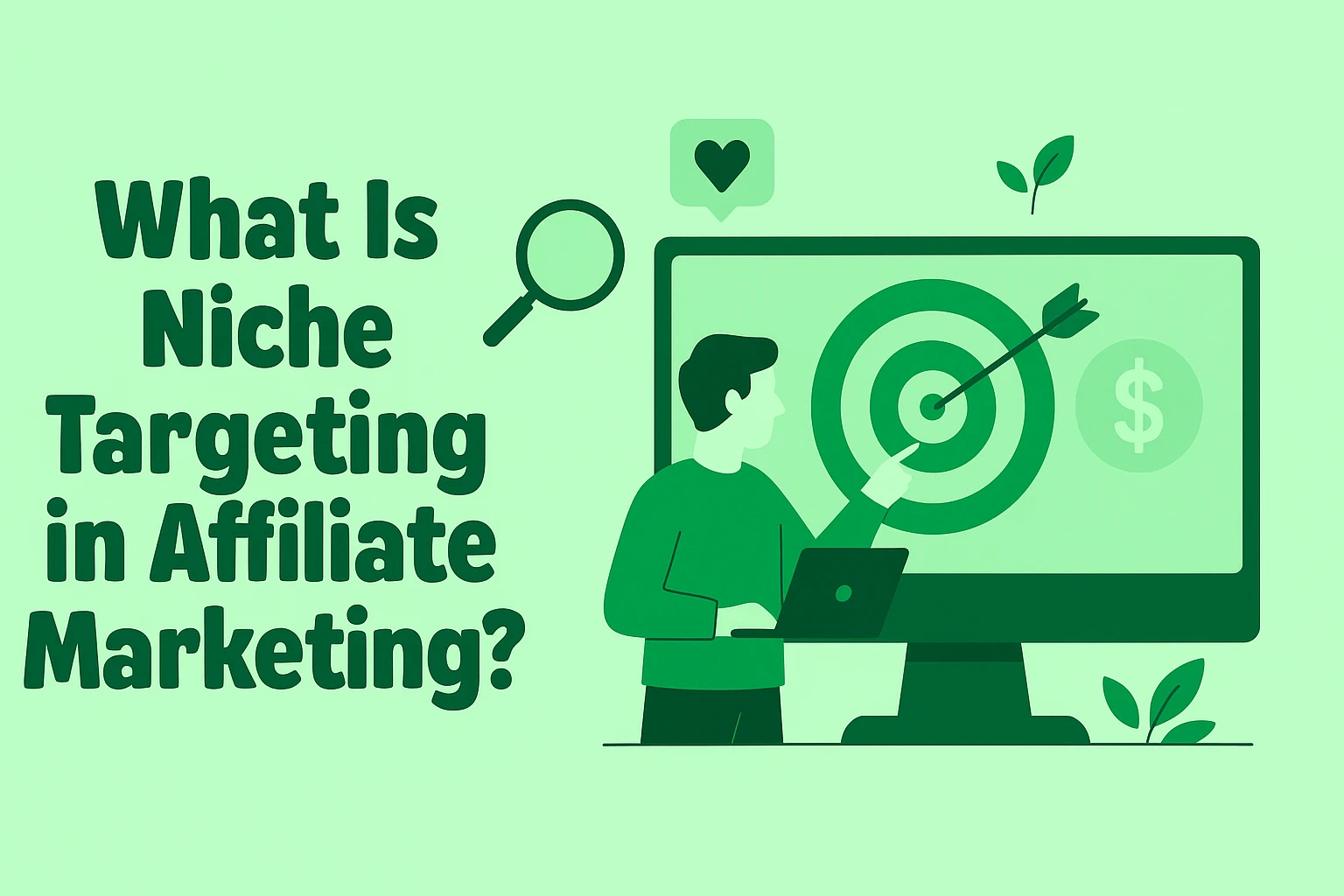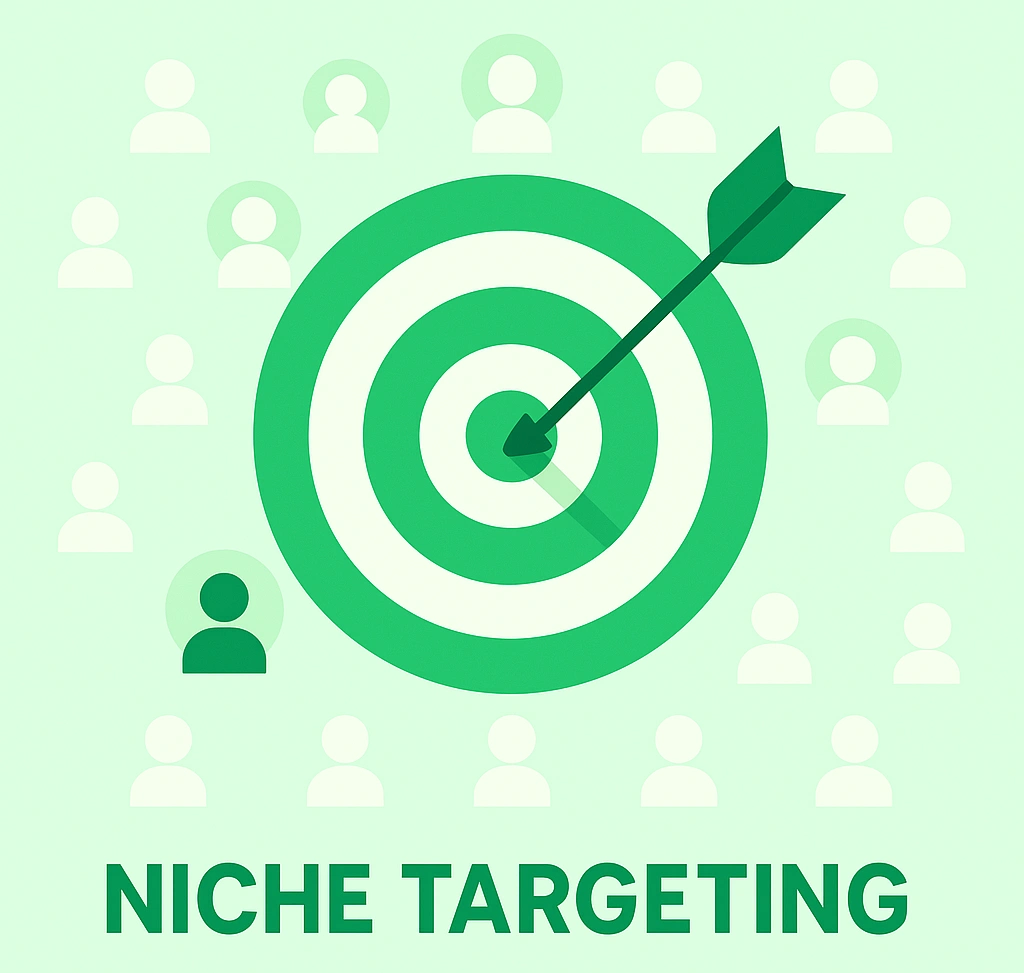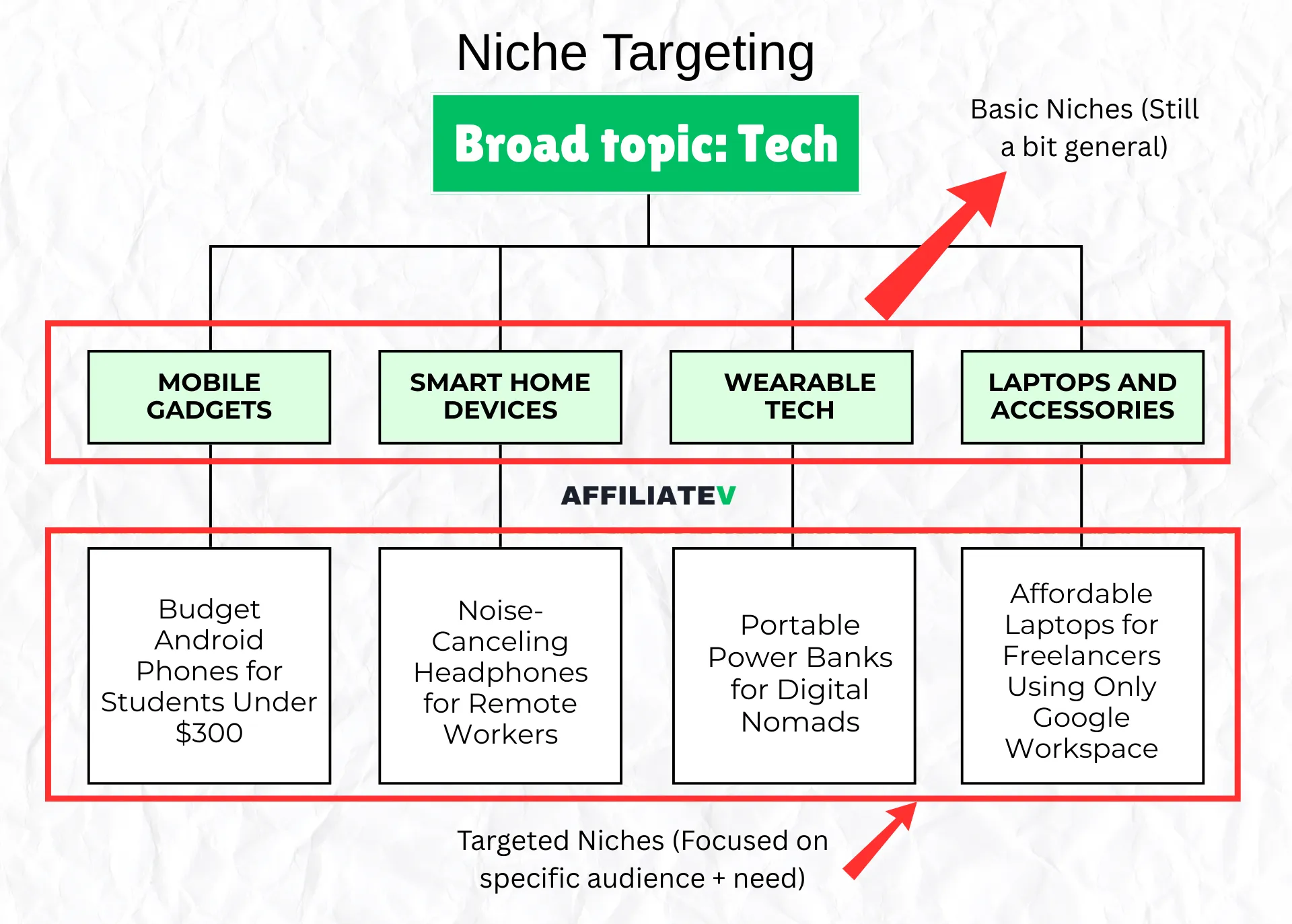What Is Niche Targeting in Affiliate Marketing? (And How It Can Make or Break Your Commissions)
Struggling with low affiliate sales? Learn what niche targeting means in affiliate marketing and how it impacts your traffic, conversions, and commissions.

When I started out with affiliate marketing, I thought the more products I promoted, the better my chances of earning. So, I slapped up links for fitness gear, tech gadgets, kitchen blenders, and even pet toys on the same blog. I figured traffic was traffic, right?
I was wrong.
My dashboard showed clicks here and there, but conversions? Almost nothing. I was speaking to everyone and connecting with no one. It wasn’t until I got specific, I mean…really specific—that things changed. I picked one niche, spoke directly to one type of reader, and suddenly the numbers started making sense.
That’s what niche targeting in affiliate marketing is all about. You’re not just chasing traffic. You’re trying to match the right product to the right person, at the right time. And that starts with knowing exactly who you’re talking to and why they care.
In this guide, I’ll break down what niche targeting really means, why most affiliates skip over it, and how it can be the difference between passive clicks and steady commissions.
Let’s clear up the guesswork and get focused.
📌Key Takeaways
- Niche targeting means solving a specific problem for a specific group.
- Broad audiences rarely convert in affiliate marketing.
- A focused niche leads to higher trust, better clicks, and more sales.
- The best niches come from research, not guesses.
- Google favors niche-focused sites with depth.
- Most affiliate marketers fail by going too wide too soon.
- You can always pivot, but start narrow and expand smart.
What Is Niche Targeting in Affiliate Marketing?
Most new affiliates think niche targeting just means “picking a topic.” So they choose something broad like fitness, tech, or travel and expect that to be enough.
But a niche isn’t just a topic. It’s a mix of who you’re talking to and what problem you’re solving.
In simple terms, niche targeting means promoting affiliate products to a very specific audience with a very specific need or interest. That’s what makes your content hit harder and your links convert better.

Let me give you an example.
Say you’re in the fitness space.
- Broad topic: Fitness
- Basic niche: Women’s fitness
- Targeted niche: Busy moms looking for 20-minute home workouts with zero equipment
See the difference? That last one tells you exactly who you’re speaking to and what they’re trying to solve. That clarity shapes your content, your product choices, and even the language you use.
Same thing with tech:
- Broad topic: Tech
- Basic niche: Mobile gadgets
- Targeted niche: Budget Android phones for students under $300
Here is a clear illustration.

That’s niche targeting. You’re not throwing offers at random groups. You’re solving one person’s specific problem better than a general blog ever could.
And in affiliate marketing, relevance always beats reach.
Why Niche Targeting Matters More Than Ever
The internet is loud. Everyone’s posting, promoting, and pushing products. And most of it gets ignored.
That’s why niche targeting isn’t optional anymore, it’s the only way to stand out.
We’re in a content-heavy space now. Whatever you’re promoting, there are already a hundred other blogs, YouTube channels, or TikToks doing the same.
The ones that win?
They don’t try to please everyone. They go deep into a focused topic that speaks directly to a certain kind of person.
This is exactly what Google wants too. Their recent updates (especially E-E-A-T: Experience, Expertise, Authoritativeness, Trustworthiness) are clear on this—they reward content that shows real understanding of a specific audience or problem.
Shallow content or generic advice doesn’t work anymore.
Same goes for readers. People trust specialists, not generalists. If someone’s searching for help with meal planning for type 2 diabetes, they won’t trust a site that also talks about yoga pants, crypto, and gaming chairs.
But a blog that focuses only on diabetic-friendly nutrition? That’s where the trust and the sale happens.
Now, here’s the hard truth:
If you skip niche targeting, you’ll waste your time creating content that gets buried… and waste your ad spend sending traffic that never converts.
Niche targeting keeps your strategy tight, your message clear, and your offers aligned with what people actually need.
It’s not just about being seen. It’s about being relevant.
Real-Life Examples of Niche vs. Broad Targeting
Let’s break this down with real examples. The difference between broad and niche targeting can literally mean the difference between a few cents in commissions or a full-time income.
1. Health Niche Example
Say you’re promoting health products.
You create a blog around general “health tips” and throw in links to supplements, fitness trackers, maybe a few protein powders. Your traffic might come from all kinds of people—young, old, men, women, athletes, total beginners.
Problem is… that traffic doesn’t know what to expect from you. And worse, you don’t know what they need. So your offers feel random, and the clicks don’t turn into sales.
Now compare that to someone targeting natural supplements for men over 40 dealing with low energy.
That’s tight. The content can speak directly to their age, their health concerns, even their daily routine. Product reviews are more focused. Blog titles are more clickable. You’ll start ranking for long-tail keywords like:
- “best supplements for men over 40 with fatigue”
- “natural testosterone booster reviews”
That kind of targeting builds trust fast. It tells the reader: this content is for you—not everyone else.
2. Tech Niche Example
Now look at tech.
If your blog is just about “gadgets,” you’re swimming in a massive pool. You might review phones, laptops, speakers, fitness watches, drones—all in the same place. But unless someone already trusts you, that general mix won’t grab their attention.
Now take a niche like budget noise-canceling earbuds for students.
You can focus every post around sound quality, battery life, online class use, price points under $50—all the stuff that matters to students. You’re solving one problem for one audience. So instead of ranking for generic “best earbuds,” you’re targeting:
- “cheap noise-canceling earbuds for studying”
- “best earbuds for online lectures under $30”
That kind of content gets found faster, clicked more, and earns trust right away.
So What Makes One Convert and the Other Fail?
The broad examples might bring in more random traffic but that traffic won’t feel connected. The messaging’s too weak. The products don’t match their needs. So they bounce.
The niche examples speak directly to a real pain point. They give the reader confidence that they’re in the right place and that you understand their situation. That’s what drives conversions.
It’s not about reaching more people. It’s about reaching the right ones and giving them what they came for.
How to Choose a Profitable Niche Without Guessing
Picking a niche shouldn’t feel like rolling dice. You don’t need to “go with your gut” or copy what’s trending on Twitter. There’s a smarter way to do it—by paying attention to what real people are already searching for and struggling with.
Let’s walk through it.
1. Start With Keyword Tools (Free and Paid)
Use tools like Ubersuggest, KeySearch, Google Trends, Answer the Public, or even Google’s autocomplete.
Let’s say you’re curious about the men’s health space. Type in:
natural supplements for men over 40
You’ll see keyword ideas like:
- “best supplements for energy for men over 40” (1,600 monthly searches)
- “natural testosterone booster for men” (4,400 searches)
- “ashwagandha for men over 40” (1,000+)
That’s real, targeted demand. These numbers show people are looking for help, but the search terms are specific enough that big-name sites might not dominate every result.
2. Check Out Forums, YouTube Comments, Reddit
This is where you find the real language people use—and the gaps big blogs miss.
Hop on a subreddit like r/Supplements or r/Frugal and look at what people are asking. Go to YouTube reviews and scan the comments. People often say things like:
- “Does this actually work for older guys?”
- “I’m broke—any budget version of this?”
- “Can I use this if I work night shifts?”
These are gold. They’re not just questions—they’re content ideas and product hooks.
3. Look for Underserved Pockets Inside Big Niches
Don’t try to take over massive markets like “fitness” or “tech.” Instead, drill down.
Let’s say the big niche is “home fitness.”
Zoom in to: resistance bands workouts for seniors with arthritis
Or: 15-minute low-impact workouts for post-pregnancy moms
These groups are active. They search a lot. But there’s less competition because most blogs go too broad.
Same thing in tech.
Instead of “headphones,” target: budget noise-canceling earbuds for students
Instead of “laptop reviews,” try: best lightweight laptops for digital nomads under $500
Those little corners are where the money’s hiding.
4. Bonus: Plug Keyword Examples Into Content Plans
Let’s take “best laptops under $500 for students.”
From that one seed, you can build a full content plan:
- “Top 5 Laptops Under $500 for College Students in 2025”
- “How to Pick a Student Laptop Without Overpaying”
- “Best Lightweight Laptops for Taking Notes in Class”
Each of these can target a long-tail keyword, speak to a real need, and include affiliate links that feel natural—not forced.
Bottom line: You don’t need a magic formula. Just listen to what people are searching, asking, and complaining about—and shape your niche around that.
Recommended Reading: How to Choose the Best Niche for Your Affiliate Marketing Business
How to Apply Niche Targeting in Your Content and Funnels
You’ve picked a niche. Great start. But if your content and funnel don’t match that niche—none of it will convert.
This is where most affiliate marketers fall flat.
They write blog posts that feel too broad, slap on a generic freebie, or promote products their audience doesn’t care about.
Niche targeting isn’t just about choosing a topic—it should shape every piece of content you create and every step in your funnel.
Let’s walk through how to do it right.
1. Start With One Core Problem
Don’t just write about your niche—solve something real inside it.
Every post, email, or freebie should answer one specific question or fix one specific problem.
Example:
Instead of “Best Fitness Gear,” go with “Best Resistance Bands for Women Recovering from Knee Injuries.”
When you narrow the focus, the right people immediately know you’re speaking to them.
2. Use Niche-Specific Language
Know the words your audience uses. This isn’t about SEO tricks—it’s about trust.
If your reader says “side hustle” and you keep saying “alternative revenue stream,” you’ll lose them.
How to find the right language:
- Read Reddit threads, blog comments, Amazon reviews
- Look at how your audience asks for help
- Mirror those exact words in your content, email subject lines, and even product descriptions
This signals, “I get you.”
3. Create Content That Filters Out the Wrong People
Good niche content should attract the right crowd—and quietly repel the rest.
Don’t try to appeal to everyone. Be clear about who your post or product is for.
Example:
- Title your blog post: “Freelance Tax Tips for First-Year Designers”
- Not: “Tax Tips for Everyone with a Side Hustle”
It’s better to have 1,000 laser-focused readers than 10,000 random clicks.
4. Align Your Lead Magnet With a Pain Point
If your freebie doesn’t solve a clear, niche-specific issue, it won’t convert.
Ask: “What’s the first thing my audience is stuck on?”
Then give them a shortcut.
Examples:
- Niche: Budget Travel → Lead magnet: “3-Day Packing Checklist for Backpackers on $50/Day”
- Niche: Solo Business Tools → Lead magnet: “Top 5 Automation Tools for Freelancers with No Time to Waste”
Make it insanely useful, not just “free.”
5. Funnel Emails Should Deepen the Niche
Once someone joins your list, your emails should keep the message tight.
Don’t veer off into general motivation or random product pushes.
Instead, stack value around that one core pain point. Add context, tips, personal stories, and soft pitches—all aimed at solving that specific problem.
Example:
If someone signs up for “Keto Meal Plans for Working Moms,” your emails should never talk about intermittent fasting for athletes.
Stay in the lane.
6. Only Promote Affiliate Products That Fit the Niche
If the offer doesn’t match the pain point your niche cares about, skip it. It might be a great product—but that doesn’t mean it’s right for your funnel.
Check these before promoting:
- Does it solve a direct problem your audience has?
- Does it use language they’ll relate to?
- Can you build real content around it (not just plug a link)?
If it’s just a promo with no connection, it won’t convert—and might hurt trust.
7. Rinse, Test, Refine
This part takes time. You won’t always hit the right message or product on the first try.
So test:
- Which blog post topics bring in the right people?
- Which lead magnets get signups?
- Which emails get clicks (and sales)?
Small data points over time will show you what your audience actually wants. Keep adjusting—but never lose sight of who you’re serving.
Common Mistakes Affiliate Marketers Make With Niche Targeting
Most affiliate marketers mess up niche targeting without even realizing it. They think they’re being specific—but they’re still missing the mark.
Here’s where things usually go sideways:
1. Going Too Broad (Again)
“I’m targeting the fitness niche.”
Okay… but fitness for who?
Busy dads?
Crossfitters?
People with injuries?
Seniors?
If your niche still attracts five completely different types of readers, it’s not a niche. It’s a big box store with no personality. Broad blogs might get traffic, but conversions stay low because the message is too generic.
2. Chasing Trends With No Buyer Intent
A niche isn’t hot just because it’s trending.
Let’s say AI tools are all over social media. You build content fast—“Top 10 Free AI Tools.” It might get views, but most people searching that are curious, not ready to spend.
You want niches where people are actively looking to solve a problem—not just scrolling out of boredom.
3. Creating Content That Doesn’t Match the Audience’s Needs
You pick a niche like “budget skincare for teens,” but you’re reviewing $80 serums and collagen supplements.
That’s a mismatch. Your audience won’t relate, and they won’t trust you.
Good niche targeting isn’t just about the topic—it’s about staying inside the reality of your audience.
Budget means budget. Teen means no retinol lectures or anti-aging routines. Keep it real.
4. Copying Someone Else’s Niche Without Context
You see someone crushing it with “golf gadgets for seniors,” and you jump in with the same angle.
But they’ve been in the space for years, they’re a golfer themselves, and their content has real-life experience behind it.
You? You don’t even own a putter.
The audience will feel that disconnect. Niche targeting only works if you understand the group you’re serving—or you’re willing to research like crazy and speak their language.
The takeaway?
Niche targeting only works when it’s tight, real, and built around what buyers actually want. Otherwise, you’re just posting content that no one sticks around for.
Quick Checklist: Are You Targeting the Right Niche?
Now, here is a quick checklist. Before you build more content or worse, waste more time, run through this list. If you can’t check most of these, you’re probably targeting too wide, too vague, or too cold.
| ✅ Checklist Item | Explanation / Example |
|---|---|
| You’re solving one clear problem for one specific type of person | Example: Not just “fitness” but “home workouts for postpartum moms.” |
| People are already searching for your topic (with buying intent) | Use Ubersuggest, KeySearch, Google Trends, or YouTube search. Look for long-tail phrases like “best low-impact workouts after pregnancy”—not just “fitness tips.” |
| Your content ideas match what that audience actually cares about | If your niche is “budget tech for students,” don’t review $400 earbuds. Stay inside their world. |
| You can list at least 5 affiliate products that truly fit your niche | No forced links. No random Amazon junk. The products should solve the exact problem your audience has. |
| You’re not copying someone’s niche just because it looks profitable | You either have experience with the topic, or you’re committed to understanding the audience better than anyone. |
| Forums, Reddit, and comment sections confirm the demand | If people are talking about it, asking about it, and getting half-baked answers—that’s a good sign. |
| You’re excited to create 10+ pieces of helpful content around the niche | If you can’t go deep, your audience won’t stay long. Niche targeting only works when you’re all in. |
Want help finding your niche?
Grab the Niche Navigator: How To Find A Profitable Niche In 1 Hour—a simple, no-fluff workbook and keyword guide designed to help you spot high-converting niches fast.
It walks you through what to look for, where to find real buyer signals, and how to avoid the usual traps affiliate marketers fall into.
Use it, test it, and let it guide your next affiliate project—so you’re not just picking a niche, you’re building one that earns.
Final Thoughts: Niche Targeting Is a Skill—Not a Guess
Most affiliate marketers treat niche targeting like a one-time decision. Pick a topic. Create some posts. Hope it works.
But that’s not how it plays out in real life.
Getting your niche right takes testing. You try angles, watch what hits, and adjust. You dig into keyword data, audience feedback, and your own experience. Over time, you stop guessing and start understanding what your audience actually wants.
And here’s the part most people miss:
Your niche doesn’t have to stay frozen. It can shift as your audience grows, or as you learn what gets clicks, shares, and commissions. Maybe you start in “budget home gym gear” and slowly move into “low-impact routines for busy parents.” That’s okay. That’s smart.
The key is to start focused, speak directly to a group that needs help, and let the rest evolve naturally.
If this guide helped you rethink your approach or raised more questions—drop a comment or send a message. Let’s trade ideas.
Frequently Asked Questions
What does niche targeting mean in affiliate marketing?
Niche targeting in affiliate marketing means narrowing your focus to a specific group of people with a clear problem or interest. It’s not just about picking a category like “fitness” or “tech.” It’s about choosing a particular type of person—like “busy moms looking for home workouts” or “students needing affordable tech.” From there, you promote affiliate products that speak directly to their situation. This tight focus builds trust, improves engagement, and boosts conversions. When you target everyone, you reach no one. Niche targeting helps you stand out in a crowded space by being relevant, helpful, and specific.
How do I find a good affiliate niche?
Start by asking yourself what topics you understand or care about. Then validate that idea by checking demand. Use tools like Google Trends, Ubersuggest, or even YouTube autocomplete to spot what people are searching for. Read Reddit threads, blog comments, and forums to see what real people are asking—and whether they’re getting good answers. Look for underserved areas inside big markets. For example, instead of “personal finance,” you might spot a gap in “budgeting tips for freelancers.” A good niche has real problems, real conversations, and real buyer intent. You want to serve—not just sell.
Can I make more money by targeting a broader niche?
It might look like a broader niche gives you more chances to earn, but in most cases, the opposite happens. Broad niches attract vague traffic. That means more visitors who are just browsing—not ready to buy. Plus, it’s harder to build trust because your message is too general. Niche targeting lets you speak your audience’s language, which leads to stronger clicks and higher conversions. For example, “weight loss” is broad, but “meal plans for busy nurses” is focused. The second one might get less traffic—but it’ll convert better. In affiliate marketing, clarity and relevance beat volume.
What are signs I’ve chosen the wrong niche?
If your content feels all over the place, you get low engagement, or you’re constantly struggling to find affiliate products that make sense for your audience—those are red flags. Another sign? You’re getting traffic but very few clicks or sales. Sometimes the problem isn’t your content quality—it’s the mismatch between what you’re offering and who you’re speaking to. Also, if the niche doesn’t interest you at all, burnout hits fast. The right niche makes content ideas flow and gives you a clear direction. The wrong one makes everything feel forced and frustrating.
Should I stick to one niche or explore multiple?
At the beginning, stick to one niche. Focus helps you build authority, understand your audience, and create content that actually converts. Jumping into multiple niches too early spreads your time, energy, and resources too thin. You’ll end up with shallow content and low trust across the board. Once you’ve built a system that works—traffic, trust, and commissions—then you can consider branching out. But even then, each new niche should get its own space: separate blog, email list, or funnel. Don’t mix them all under one roof. Start small. Grow smart.






